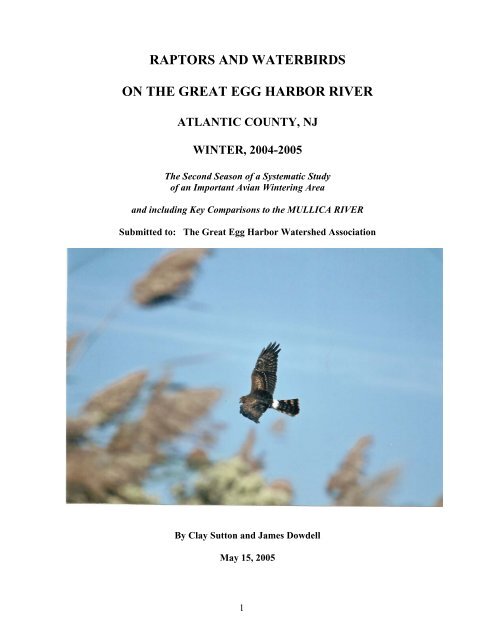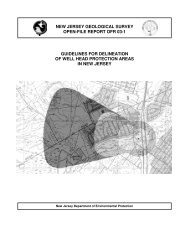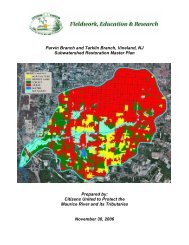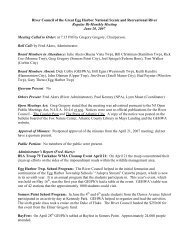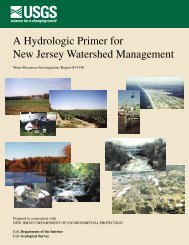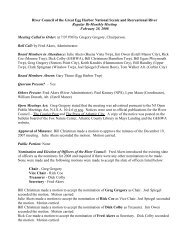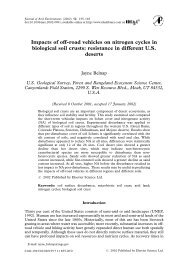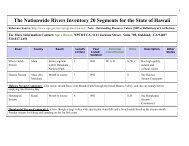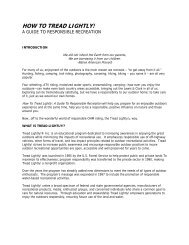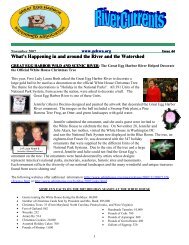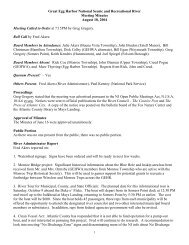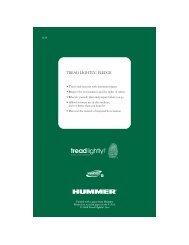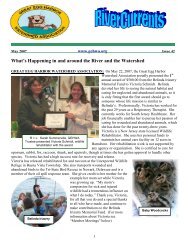GEHR 04-05 Final Rep.. - Great Egg Harbor Watershed Association
GEHR 04-05 Final Rep.. - Great Egg Harbor Watershed Association
GEHR 04-05 Final Rep.. - Great Egg Harbor Watershed Association
Create successful ePaper yourself
Turn your PDF publications into a flip-book with our unique Google optimized e-Paper software.
RAPTORS AND WATERBIRDS<br />
ON THE GREAT EGG HARBOR RIVER<br />
ATLANTIC COUNTY, NJ<br />
WINTER, 20<strong>04</strong>-20<strong>05</strong><br />
The Second Season of a Systematic Study<br />
of an Important Avian Wintering Area<br />
and including Key Comparisons to the MULLICA RIVER<br />
Submitted to: The <strong>Great</strong> <strong>Egg</strong> <strong>Harbor</strong> <strong>Watershed</strong> <strong>Association</strong><br />
By Clay Sutton and James Dowdell<br />
May 15, 20<strong>05</strong><br />
1
Submitted to:<br />
The <strong>Great</strong> <strong>Egg</strong> <strong>Harbor</strong> <strong>Watershed</strong> <strong>Association</strong><br />
c/o Fred Akers, Administrator<br />
P.O. Box 395<br />
Newtonville, N.J.<br />
08346<br />
Submitted by:<br />
Clay Sutton<br />
Writer, Lecturer, Naturalist, Biologist<br />
129 Bucks Avenue<br />
Cape May Court House<br />
NJ 08210<br />
2
TABLE OF CONTENTS<br />
Executive Summary ........................................................................................................................ 4<br />
Introduction ..................................................................................................................................... 5<br />
Goals and Objectives....................................................................................................................... 6<br />
Methodology ................................................................................................................................... 7<br />
Map of the Study Area .................................................................................................................... 9<br />
Findings:<br />
Winter Raptors ...................................................................................................................... 10<br />
Waterfowl and Waterbirds .................................................................................................... 14<br />
Comparisons to Previous Season’s Findings ........................................................................ 19<br />
Comparisons to the Mullica River ........................................................................................ 22<br />
Comparisons to Mullica River Historical Data ..................................................................... 29<br />
Discussion ..................................................................................................................................... 34<br />
Conclusions and Recommendations.............................................................................................. 35<br />
Acknowledgments......................................................................................................................... 37<br />
Literature Cited / For Further Reference....................................................................................... 38<br />
Appendix 1: RT&E Species Locations Field Maps ...................................................................... 40<br />
On the Cover:<br />
Perhaps no raptor is more iconic of the <strong>Great</strong> <strong>Egg</strong> <strong>Harbor</strong> River than the Northern Harrier. Found<br />
throughout the length and breadth of the study area, from Mays Landing east to the Longport sod<br />
banks, the harrier or “Marsh Hawk” is a common sight from early fall through late spring. A few<br />
pairs remain to breed in the vast wetlands of the <strong>Egg</strong> <strong>Harbor</strong> estuary. Gracing even the coldest and<br />
dreariest of winter days, the Northern Harrier may reach a maximum possible wintering density<br />
along the river - a daily average of 36 harriers were seen during winter surveys in 20<strong>04</strong>-20<strong>05</strong>.<br />
3
RAPTORS AND WATERBIRDS<br />
ON THE GREAT EGG HARBOR RIVER<br />
Atlantic County, NJ<br />
WINTER, 20<strong>04</strong>-20<strong>05</strong><br />
The Second Season of a Systematic Study<br />
of an Important Avian Wintering Area<br />
and including Key Comparisons to the Mullica River<br />
EXECUTIVE SUMMARY:<br />
In an effort to establish baseline data on raptor and waterbird use of the lower <strong>Great</strong> <strong>Egg</strong><br />
<strong>Harbor</strong> River watershed, information which can be used to determine status and trends in avian<br />
populations and use, a systematic study was established during the winter of 2003-20<strong>04</strong>. This study<br />
was continued during the winter season of 20<strong>04</strong>-20<strong>05</strong>. As in the inaugural survey, data was<br />
gathered at nine sites, for forty-five minutes per site, at a rate of approximately every two weeks<br />
during the period (from December 13, 20<strong>04</strong> to March 30, 20<strong>05</strong>) in order to assess winter<br />
populations and distribution of birds, primarily raptors and waterfowl.<br />
Substantial use of the <strong>Great</strong> <strong>Egg</strong> <strong>Harbor</strong> River system was again proven. Systematic<br />
sampling determined raptor use of the <strong>Great</strong> <strong>Egg</strong> River and estuary to be substantial and on par not<br />
only with the lower Maurice River (the only other southern New Jersey system for which<br />
substantial systematic data exists), but also with the Mullica River, a well-known and excellent<br />
winter area for birds. Raptor, waterfowl and waterbird use of the system was found to be well<br />
higher than that indicated by both previous anecdotal accounts and 2003-20<strong>04</strong> findings. This was<br />
particularly noteworthy on <strong>Great</strong> <strong>Egg</strong> <strong>Harbor</strong> Bay, where winter Brant and diving duck numbers<br />
were found in concentrations higher than previously reported, and in numbers highly significant for<br />
the region.<br />
In 20<strong>04</strong>-20<strong>05</strong>, <strong>Great</strong> <strong>Egg</strong> <strong>Harbor</strong> River winter raptors and waterfowl were again documented<br />
in numbers judged to be substantial and regionally significant to New Jersey and in the Mid-<br />
Atlantic states.<br />
4
GREAT EGG HARBOR WINTER RAPTORS AND WATERBIRDS<br />
INTRODUCTION:<br />
The <strong>Great</strong> <strong>Egg</strong> <strong>Harbor</strong> River, including its important Tuckahoe River tributary, is one of<br />
New Jersey’s great river and bay systems. The <strong>Great</strong> <strong>Egg</strong> easily rivals the Mullica / Wading River<br />
complex, the Maurice River, and the Cohansey River as one of the largest and most important river<br />
and estuary systems in southern New Jersey. Despite a long history of settlement in the areas<br />
surrounding the river, and despite recent and substantial regional growth and development, much of<br />
the <strong>Great</strong> <strong>Egg</strong> <strong>Harbor</strong> River remains wild and scenic, and many areas would yet qualify as pristine<br />
under many standards of review. The <strong>Great</strong> <strong>Egg</strong> is certainly one of South Jersey’s gems - in scenic<br />
vistas, natural resources, wildlife use, and recreation and ecotourism opportunities.<br />
Despite a well-established reputation for substantial wildlife populations and avian-use prior<br />
to 2003-20<strong>04</strong>, surprisingly little systematic ornithological data had been gathered on the <strong>Great</strong> <strong>Egg</strong><br />
<strong>Harbor</strong> or Tuckahoe Rivers. Most published avian use data was anecdotal at best -- chance<br />
sightings or non-systematic surveys (such as Christmas Bird Counts). Such records hinted at<br />
exceptional bird use of the area, but unfortunately offered biologists or planners little definitive data<br />
for resource management, land use planning options, decision-making, and protection strategies.<br />
Compared to the long-term in-depth studies on the Cumberland County’s Maurice River,<br />
and to lesser yet substantial data on the Cohansey River, little was known of raptor (hawk and<br />
eagle), waterbird, and shorebird use of the <strong>Great</strong> <strong>Egg</strong> system. (Herein waterbirds are defined<br />
largely as waterfowl - ducks and geese, and wading birds - herons, egrets, and ibis). The Maurice<br />
and the Cohansey have been intensively studied as compared to the <strong>Great</strong> <strong>Egg</strong> <strong>Harbor</strong> and<br />
Tuckahoe River system.<br />
In winter, 2003-20<strong>04</strong>, a systematic survey of <strong>Great</strong> <strong>Egg</strong> <strong>Harbor</strong> River avian resources was<br />
initiated. While ornithological findings for that season were important in their own right, most<br />
importantly the establishment of a systematic survey methodology, route, and data collection<br />
mechanism could allow for comparisons over time. Because this single-season effort did not allow<br />
for assessment of long term status and trends, a second winter season study was continued in 20<strong>04</strong>-<br />
20<strong>05</strong>. Although the first season’s effort provided an excellent baseline for future, identical<br />
systematic studies, there was no way of knowing whether the first season’s results were truly<br />
representative, or whether they represented an average, “good,” or even “bad” year for winter birduse.<br />
These questions were in-part substantially answered in 20<strong>04</strong>-20<strong>05</strong>.<br />
5
GOALS AND OBJECTIVES:<br />
In winter 2003-20<strong>04</strong>, a winter raptor and waterbird survey was funded and initiated by the<br />
<strong>Great</strong> <strong>Egg</strong> <strong>Harbor</strong> <strong>Watershed</strong> <strong>Association</strong>. These studies were continued in winter 20<strong>04</strong>-20<strong>05</strong>, and<br />
reported on herein. In the mid-Atlantic region, winter is an exceptional time for bird-use,<br />
particularly raptor and waterfowl use of regional river and coastal wetlands habitats. Vast river and<br />
bay systems attract and support both a variety and large numbers of winter birds - birds which have<br />
migrated in autumn from regions farther north and west, including high Arctic regions, to feed in<br />
ice-free river and bay habitats. Winter is key time of bird-use in southern New Jersey and a crucial<br />
time in the life cycle and survival of all Mid-Atlantic hawks, eagles, and waterfowl.<br />
Although important avian use of the <strong>Great</strong> <strong>Egg</strong> occurs on a year-bound basis, the suspected<br />
importance of the area as a key wintering area called for systematic surveys to be conducted during<br />
the highly important winter season - at a time when raptor and waterfowl numbers are at their<br />
seasonal highest in the region. The goals of this <strong>Great</strong> <strong>Egg</strong> <strong>Harbor</strong> raptor and waterfowl survey, as<br />
determined in concert with the <strong>Great</strong> <strong>Egg</strong> <strong>Harbor</strong> <strong>Watershed</strong> <strong>Association</strong>, are as follows:<br />
1. The establishment of an avian data base which, over time, can be used to determine<br />
status and trends in bird populations and bird use - such baseline data would be of particular<br />
importance as land use changes accelerate in the watershed.<br />
2. The determination of key use areas by birds - possible eventual habitat rankings could<br />
be of real value in directing resource protection and acquisition prioritization.<br />
3. Submission of rare, threatened and endangered species records to the Endangered<br />
and Nongame Species Project of the DFW, NJDEP. By submission of a copy of this report,<br />
including mapping, findings of this study will supplement and aid ENSP’s Landscape Project,<br />
proposed habitat rules, and other Department programs in protecting key <strong>Great</strong> <strong>Egg</strong> region habitats.<br />
4. Bring recognition and publicity to the considerable avian resources of the <strong>Great</strong> <strong>Egg</strong><br />
watershed. While there is much anecdotal information on the area’s bird life, no systematic raptor<br />
or waterbird studies had been carried out prior to 2003-20<strong>04</strong> on the <strong>Great</strong> <strong>Egg</strong> (excepting the<br />
DFW’s twice-annual waterfowl counts). The lack of <strong>Great</strong> <strong>Egg</strong> data on winter raptors, a hallmark<br />
feature of South Jersey river systems, was at the time noteworthy in its absence - far less was known<br />
about the <strong>Great</strong> <strong>Egg</strong> <strong>Harbor</strong> River than is known about the Maurice, Cohansey, or even the nearby<br />
Mullica River to the north.<br />
5. The key objective of the survey efforts is to discover and provide cornerstone avian<br />
resource data to be used in river management and protection. Baseline knowledge backed by<br />
strong systematic data can play a crucial role in decision making, land-use planning, and resource<br />
management on the great <strong>Egg</strong> <strong>Harbor</strong> River. Long-term monitoring, leading to a true understanding<br />
of avian status and trends over time (and in relation to a rapidly changing landscape), should play an<br />
important part in planning and protection for the Scenic and Recreational <strong>Great</strong> <strong>Egg</strong> <strong>Harbor</strong> River.<br />
6
METHODOLOGY:<br />
As in the inaugural 2003-20<strong>04</strong> study, the winter 20<strong>04</strong>-20<strong>05</strong> season raptor and waterbird<br />
survey on the <strong>Great</strong> <strong>Egg</strong> <strong>Harbor</strong> River was conducted systematically between the second week of<br />
December and the fourth week of March. Nine surveys were conducted, at roughly the rate of once<br />
every two weeks during the winter period. It should be noted that the December period sees some<br />
late “fall” migration into the South Jersey region, and that March is a time of substantial spring<br />
migration build-up, particularly in waterfowl numbers. Ten winter surveys had been planned, but<br />
due to a combination of snow, ice, and scheduling conflicts, only nine were carried out.<br />
Two observers, Sutton and Dowdell, spent 45 minutes apiece at each of nine sampling sites.<br />
All raptors and waterbirds were tallied at each site, whether in flight or sitting (perched or on the<br />
water). All hawks and eagles were searched for in accordance with Sutton and Sutton (1996).<br />
Raptors were identified, aged, and sexed in accordance with Dunne, Sibley, and Sutton (1986),<br />
Clark and Wheeler (1987), and Wheeler and Clark (1995). Waterbirds were found and identified in<br />
accordance with Sibley (2000), Sutton, et al., (20<strong>04</strong>), and, of course, the two authors’ many years of<br />
extensive experience in Southern New Jersey and elsewhere. (Clay Sutton’s resume is found at the<br />
end of this report).<br />
Additional birds, most often raptors, observed between official count sites were recorded if<br />
and only if the observers were confident it had not previously counted. For example, a low-flying<br />
Cooper’s Hawk dashing across the road would be added to the count if it had not been observed at<br />
the previous site. While the nine sampling sites were generally far enough apart to preclude<br />
“double-counting,” the observers used extreme care to avoid recounting the same bird or birds. For<br />
example, eagles range widely up and down the river; a Bald Eagle roosting at Lake Lenape may<br />
range east to Tuckahoe WMA or farther. A “new” eagle would only be counted when direction of<br />
flight, age, plumage, or circumstance would allow the observers to confidently assess that it could<br />
not possibly have been already counted. Due to such constraints, counts of raptors, particularly<br />
eagles, are thought to be conservative. As discussed below, the <strong>Great</strong> <strong>Egg</strong> basin is a very large area,<br />
extremely wide in the lower portions.<br />
The nine count locations, the official sampling sites, are shown on Map 1. Some sites did<br />
have supplemental count locations (labeled A, B, and C on our field maps, but not on Map 1) to<br />
allow for all areas to be seen and thereby all birds counted. For example, the Tuckahoe WMA site,<br />
Site 9, southeast of Tuckahoe has three impoundment pools, and not all pools can be viewed or<br />
counted from the same location. Therefore, the Site 9 count is a composite of tallies taken at three<br />
separate locations, but only one final tally is given for the site on the daily and summary data sheets.<br />
In this case, the 45 minutes are expended at the three stops put together. Only by using such<br />
alternate viewing locations could all birds, particularly waterbirds, be reasonably and reliably<br />
tallied.<br />
7
In order to avoid bias in the sampling technique, the route was reversed each subsequent<br />
sampling date, run “upriver” and then “downriver” on alternate sampling days. The nine sites<br />
ultimately settled upon as a reasonable and doable sampling route are as follows, (starting on the<br />
lower estuary and working upriver):<br />
(1) Longport Bridge Fishing Pier. This site allowed counting of the lower portion of<br />
<strong>Great</strong> <strong>Egg</strong> <strong>Harbor</strong> Bay and the Rainbow Channel/Rainbow Island area.<br />
(2) John F. Kennedy park in Somers Point. Allowed counting of the bay east of the<br />
Garden State parkway Bridge. An alternate site was employed here; the foot of the<br />
Route 9 Bridge over <strong>Great</strong> <strong>Egg</strong> <strong>Harbor</strong> bay (north end) allowed the bay west of the<br />
bridges to be seen and censused.<br />
(3) Jeffers Landing, including alternate sites on Job’s Point Road and Jeffers Landing<br />
Road.<br />
(4) English Creek Landing, at Wharf Road.<br />
(5) The “Upper” tidal river. The principal count location was from the Shady River<br />
Marina on Route 559. A supplemental site used was “the bulkhead” in Mays<br />
Landing just south of Route 40.<br />
(6) Lake Lenape. Observations were conducted from the spillway in Mays Landing.<br />
(7) Gibson Landing, at the end of Gibson’s Creek Road in the Corbin City unit of<br />
Tuckahoe WMA.<br />
(8) The observation tower on the dikes of the Corbin City unit of the Tuckahoe WMA.<br />
Here supplemental observation points were used in order to observe all of the various<br />
nooks and crannies of the several impoundments.<br />
(9) The Tuckahoe unit of the Tuckahoe WMA, including three supplemental stops<br />
which allowed all three impoundments to be viewed and counted. Particularly Site 9<br />
allowed those raptors and waterfowl using the lower Tuckahoe River tributary to the<br />
Lower <strong>Great</strong> <strong>Egg</strong> <strong>Harbor</strong> River basin area to be included in survey results. This site<br />
was in Cape May County; all others were in Atlantic County, NJ.<br />
To the greatest extent practicable, all counts were conducted in good weather. The<br />
observers carefully selected sampling days which were sunny and breezy, conditions which readily<br />
facilitate raptor hunting and movement along the river. Such conditions particularly allow for the<br />
best raptor counts (on cloudy, windless days raptors often spend much of their time perched, and<br />
therefore often are out of sight).<br />
8
FINDINGS:<br />
The results of the <strong>Great</strong> <strong>Egg</strong> <strong>Harbor</strong> River Winter Raptor and Waterbird Survey for winter<br />
20<strong>04</strong>-20<strong>05</strong> are shown in Table 1. Nine full surveys were carried out in the time period between<br />
December 13, 20<strong>04</strong> and March 30, 20<strong>05</strong>.<br />
Table 1 also shows the average (mean) count for key species, and peak daily high counts are<br />
shown in boldface. While average counts are of value in comparing data from year to year, and in<br />
part reflect the amount of time over the season which birds spend on the river (as well as the<br />
inevitable impacts of both daily and prolonged weather conditions upon count results), the peak<br />
count for many species far better reflects the true numbers present. For example, the peak of 1,238<br />
American Black Ducks recorded on February 1 far better reflects the number present than the mere<br />
248 counted 12 days earlier. Weather, ice, cloud conditions, and access can greatly vary and alter<br />
the results of any given survey. This is why a minimum of 8-10 surveys are required to truly assess<br />
bird populations present in the system.<br />
WINTER RAPTORS:<br />
Fifteen species of diurnal raptors were recorded over the course of the survey period<br />
representing excellent winter diversity for the mid-Atlantic region. Beyond variety, hawk and eagle<br />
numbers were again found to be high as well.<br />
Black Vulture<br />
Black Vultures continue to expand their range and numbers in New Jersey. Although few<br />
winter in the <strong>Great</strong> <strong>Egg</strong> area, a high of 5 was seen on January 7, and an average of 3.2 per visit was<br />
counted.<br />
Turkey Vulture<br />
Turkey Vultures are far more common on the river in winter than Black Vultures. Seventysix<br />
were seen on average and a high count of 110 was estimated on March 30, 20<strong>05</strong>.<br />
Osprey<br />
Osprey are not an expected wintering bird in New Jersey or in the mid-Atlantic. The five<br />
Osprey counted on March 16 represent returning spring migrants (breeding birds) to the <strong>Great</strong> <strong>Egg</strong>.<br />
Forty-five Osprey, a combination of local breeders and northbound migrants, were tallied on March<br />
30, 20<strong>05</strong>.<br />
10
Bald Eagle<br />
Bald Eagles are a hallmark of the <strong>Great</strong> <strong>Egg</strong> in winter. A high count of 11 was seen on<br />
February 2, 20<strong>05</strong> when ice, snow, and harsh conditions to the north of New Jersey drove many birds<br />
south to our region. An excellent average of 7.3 Bald Eagles were seen on the official surveys. The<br />
<strong>Great</strong> <strong>Egg</strong> complex is one of the best and most reliable places in coastal southern New Jersey to see<br />
Bald Eagles. On the Atlantic coast of New Jersey, only the Mullica River/Wading River complex<br />
rivals the <strong>Great</strong> <strong>Egg</strong> for numbers of wintering eagles. At least three pairs of Bald Eagles nest along<br />
the <strong>Great</strong> <strong>Egg</strong> and Tuckahoe rivers: at Lake Lenape, on the Upper Tuckahoe, and near Scull<br />
Landing. Two adult Bald Eagles seen copulating on January 21 on an Osprey nest just west of the<br />
marina (Site 5) led to speculation of an additional nesting pair - possibly in the South River/Atlantic<br />
County park area.<br />
Golden Eagle<br />
The <strong>Great</strong> <strong>Egg</strong> is one of the top areas in New Jersey and the mid-Atlantic to see wintering<br />
Golden Eagles and is rivaled only by the Mullica River system. Seven Golden Eagle sightings were<br />
accrued, including two on December 13 and two on December 28. A minimum of three individuals<br />
were noted (based on age and plumage differences).<br />
Northern Harrier<br />
Northern Harriers of “Marsh Hawks” are another hallmark species on the <strong>Great</strong> <strong>Egg</strong> winter<br />
marshes. Harriers wintered in large numbers - 47 were counted on January 7 and again on February<br />
2, and an average of 36 was accrued - excellent totals for New Jersey and particularly for the<br />
Atlantic coastal marshes.<br />
Sharp-shinned Hawk<br />
This small accipiter was present in significant numbers. An excellent peak of seven were<br />
counted on February 2, yet Sharp-shins averaged only 1.7 per survey. Secretive in winter, no doubt<br />
far more were present than tallied (as the peak clearly suggests).<br />
Cooper’s Hawk<br />
Coopers, although also retiring in winter, were more conspicuous than Sharp-shins along the<br />
<strong>Great</strong> <strong>Egg</strong>. A peak of five were tallied on January 7 and an average of 1.9 was achieved. No doubt<br />
a number of Cooper’s Hawks remain along the <strong>Great</strong> <strong>Egg</strong> to breed, in part attested by a territorial<br />
chase witnessed on the (early!) date of January 7 at Tuckahoe WMA. Two adult male Coopers<br />
engaged in a lengthy territorial chase, followed by the “victor’s” full display flight - probably over a<br />
watching female. Cooper’s breeding was also confirmed in the area by a DOR (dead-on-road) roadkilled<br />
freshly-fledged juvenile Cooper’s Hawk found at mile marker 26.9 on the Garden State<br />
parkway on July 29, 20<strong>04</strong> (by Sutton).<br />
11
Northern Goshawk<br />
Goshawks are rare in winter anywhere in New Jersey. In 20<strong>04</strong>-20<strong>05</strong>, only one was seen<br />
near English Creek Landing on January 21.<br />
Red-shouldered Hawk<br />
Another inconspicuous, shy species in winter, Red-shoulders averaged .6 birds per survey -<br />
buoyed by the peak three individuals seen on February 2, 20<strong>04</strong>. Due to widely varying localities,<br />
probably at least five wintered in the lower <strong>Great</strong> <strong>Egg</strong> study area.<br />
Red-tailed Hawk<br />
Red-tails are the most obvious and conspicuous of all our wintering raptors, and were<br />
present along the length of the <strong>Great</strong> <strong>Egg</strong> in excellent numbers - attracted by the bounty and feeding<br />
opportunities provided by the vast salt marshes. A peak of 56 were seen on January 20, and an<br />
average of 44.8 were seen per survey. These are significant numbers for anywhere in New Jersey.<br />
Rough-legged Hawk<br />
Even prior to these studies, the Tuckahoe/Corbin City/<strong>Great</strong> <strong>Egg</strong> complex was widely<br />
known to be virtually the best place to see Rough-legs in New Jersey. The second year of survey<br />
efforts only confirmed and corroborated this reputation. 4.6 Rough-legs were seen per survey and<br />
an excellent peak of ten were tallied on February 2. During each winter season, the vast marshes of<br />
the lower river attract good numbers of this charismatic and irruptive winter visitor from the high<br />
Arctic regions.<br />
American Kestrel<br />
Once again, no American Kestrel wintered in the study area. The three seen on March 30<br />
were all spring migrants - seen high overhead heading north. The American Kestrel, once common<br />
in the general area, has virtually disappeared as a wintering bird throughout southern New Jersey.<br />
Merlin<br />
Merlin winter in only small numbers on the mid-Atlantic Coast. Three individuals were<br />
seen, with a very good two individuals noted on December 28.<br />
Peregrine Falcon<br />
At least three or four Peregrines spent the winter in the <strong>Great</strong> <strong>Egg</strong> Region. This includes the<br />
nesting pair from the Tuckahoe WMA hack tower “eyrie” (maintained by ENSP) and one or two<br />
other Peregrines as well. Peregrines averaged an excellent 1.6 per survey, peaking at three on both<br />
December 13 and February 2. The Beesley’s Point power plant cooling tower was found to be a<br />
popular Peregrine winter roost site.<br />
12
Short-eared Owl<br />
Crepuscular if not truly diurnal in its habits, the Short-eared Owl is the one owl which can<br />
be adequately censused during daylight hours (and using the methodology of this study). As with<br />
Rough-legged Hawk, the great <strong>Egg</strong> <strong>Harbor</strong> River area, specifically the dikes at Tuckahoe WMA<br />
(both the Corbin City and Tuckahoe sides), have long been known to be one of the best and most<br />
reliable places in all of New Jersey to find and enjoy Short-eared Owls. Thirteen Short-eared Owls<br />
were seen on five dates; a peak of seven Short-ears were seen during the December 28 survey, all<br />
from Site 9. At least another ten were known to be on the Corbin City side (Sites 7 and 8) in winter<br />
20<strong>04</strong>-20<strong>05</strong> – often reported by others, particularly and reliable by Karen and Brian Johnson. A<br />
targeted effort (at dusk) would have undoubtedly revealed additional Short-ears, but it can be<br />
conservatively reported that at least 17-20 Short-eared Owls wintered on the lower <strong>Great</strong> <strong>Egg</strong>.<br />
Accordingly, the <strong>Great</strong> <strong>Egg</strong> again amply maintained its reputation for hosting some of the highest<br />
regional numbers of this always exciting wetland / open country owl species.<br />
13
WINTER WATERFOWL AND WATERBIRDS:<br />
<strong>Great</strong> <strong>Egg</strong> <strong>Harbor</strong> Bay was again found to be an excellent wintering area for waterbirds.<br />
Good numbers of Common and Red-throated Loons and Grebes use the lower bay in winter. The<br />
<strong>Great</strong> <strong>Egg</strong> <strong>Harbor</strong> Bay area is unique in southern New Jersey in having a substantial population of<br />
wintering Double-crested Cormorants. A winter high of 69 was tallied on February 16; the 464<br />
counted on March 30 included many northbound spring migrants.<br />
Nine species of shorebirds were found by survey efforts. Winter is not a time of substantial<br />
shorebird use in the mid-Atlantic, yet shorebirds were again found to use <strong>Great</strong> <strong>Egg</strong> <strong>Harbor</strong> Bay<br />
mudflats in some numbers - mostly east of the Garden State Parkway Bridge. 450 Dunlin were<br />
counted on January 21, and at least 52 American Oystercatchers wintered or attempted to winter. A<br />
targeted shorebird survey in spring and fall on the bay mudflats would undoubtedly document major<br />
shorebird use during the migration season.<br />
Waterfowl use of the <strong>Great</strong> <strong>Egg</strong> <strong>Harbor</strong> River and Bay system was again found to be<br />
substantial and highly significant in the region and in New Jersey. Twenty-eight species of<br />
waterfowl were found by 20<strong>04</strong>-20<strong>05</strong> survey efforts, and high regional concentrations were again<br />
documented for a number of key species.<br />
Canada Goose<br />
The average of 359 per survey for the route were augmented by the peak count of 906 on<br />
February 21. While some Canadas were “local” geese, the high mid-winter counts included wild<br />
migrant Canadas driven to the region by snow and ice conditions farther north.<br />
Brant<br />
Among waterfowl, Brant are a hallmark species of <strong>Great</strong> <strong>Egg</strong> <strong>Harbor</strong> Bay, attracted in vast<br />
flocks to the area’s rich shallow water bays and mudflats. The peak count of 5,440 on January 7 is<br />
regionally significant, and better and more accurately reflects <strong>Great</strong> <strong>Egg</strong> usage than the slightly<br />
more modest average of 3,1125.<br />
American Black Duck<br />
Likewise, the peak of 1,115 Black Ducks better reflects known use than the lower average of<br />
647. Rather than driven to the region by the harsh conditions of winter 20<strong>04</strong>-20<strong>05</strong>, there is some<br />
evidence that Black Ducks were driven from the area. During most years, Black Ducks and to a<br />
lesser degree Mallards should use the entire system in substantial numbers in winter. The peak of<br />
1,115 Black Ducks on March 16 represents northbound migrant spring “staging” on the <strong>Great</strong> <strong>Egg</strong><br />
estuary.<br />
14
Northern Pintail<br />
The peak of 796 on December 13 was a surprise - Pintails are better-known for spring<br />
“staging” in our region in early March on their return journey north. The “spring peak” was a<br />
notable 643 Pintail. It is known that ice conditions effected timing and duration of Pintail (and<br />
Mallard) migration in the region in late winter/early spring 20<strong>04</strong>-20<strong>05</strong>. A seasonal average of 364<br />
Pintail was noted.<br />
Green-winged Teal<br />
Teal numbers, although peaking at a good 859 on March 16 averaged only 229 per survey in<br />
20<strong>04</strong>-20<strong>05</strong>. Most teal, (as well as Pintails), were recorded in Tuckahoe WMA impoundments. Of<br />
note in 20<strong>04</strong>-20<strong>05</strong> was the presence of 3 male Common Teal (sometimes called “Eurasian Greenwinged<br />
Teal”) at Tuckahoe (2) and Corbin City (1) during the period (see Table 1). The three<br />
individuals recorded on March 16 and March 30 ties the known maxima for New Jersey (which was<br />
also at Tuckahoe on April 2, 1982). Of particular note is that one bird apparently truly “wintered”<br />
here (first noted January 7 and subsequently). This to our knowledge is the first record of a<br />
Common Teal wintering in New Jersey. The origin of these vagrants, as the name suggests, is<br />
Europe and Asia. Corrigendum to 2003-20<strong>04</strong> <strong>Rep</strong>ort: One Common Teal was seen at Corbin<br />
City during our 2003-20<strong>04</strong> survey efforts, on March 3, 20<strong>04</strong>, and subsequently seen by others until<br />
March 21. We somehow failed to note this significant find in our previous report!<br />
Diving Ducks<br />
The vast rafts of diving ducks found on <strong>Great</strong> <strong>Egg</strong> <strong>Harbor</strong> Bay were again a delight and a<br />
key finding of the study. Anecdotally, the <strong>Great</strong> <strong>Egg</strong> <strong>Harbor</strong> Bay had long been known to support a<br />
huge concentration of diving ducks in winter, but to our knowledge it had never been quantified. In<br />
winter 20<strong>04</strong>-20<strong>05</strong>, the bay supported a flock of over 4,300 scaup and high numbers of other divers<br />
as well.<br />
Typically, <strong>Great</strong>er Scaup outnumber Lesser Scaup by about a 10:1 ratio in salt water in<br />
winter (Walsh, et al, 1999). Therefore <strong>Great</strong> <strong>Egg</strong> <strong>Harbor</strong> Bay “scaup” are mostly <strong>Great</strong>er Scaup,<br />
yet both species were clearly present. On March 6, a peak of 4,300 scaup were tallied. This is<br />
highly significant count for southern New Jersey. In New Jersey only Raritan Bay and Sandy Hook<br />
typically have higher counts. The <strong>Great</strong> <strong>Egg</strong> <strong>Harbor</strong> Bay is an important wintering area for scaup.<br />
Red-breasted Merganser (peak 180) and Bufflehead were more scattered but present in<br />
high numbers too. Bufflehead were widely spread from near Job Point to <strong>Great</strong> <strong>Egg</strong> Inlet, an active<br />
and attractive icon of <strong>Great</strong> <strong>Egg</strong> <strong>Harbor</strong> Bay in winter. A peak 599 were tallied on March 16, and<br />
Bufflehead averaged 343 per survey in 20<strong>04</strong>-20<strong>05</strong>.<br />
Scoter were present in respectable numbers on the lower bay in 20<strong>04</strong>-20<strong>05</strong>. Over 300 Black<br />
Scoter and Surf Scoters were reliable found near Longport Bridge in late winter. The 415 Longtailed<br />
Ducks counted on March 3 on the lower bay were a highly significant regional concentration<br />
of this handsome winter visitor.<br />
15
One significant <strong>Great</strong> <strong>Egg</strong> waterbird record occurred just one day after our January 7 survey. On<br />
the following day, January 8 (and again on January 9) Karen and Brian Johnson observed an<br />
American White Pelican soaring over the river basin. One of a growing number of regional<br />
sightings of this western bird, it is none-the-less a remarkable record for mid-winter.<br />
One non-raptor/waterbird record is included at the end of Table 1. On January 21, we<br />
watched two Red-headed Woodpeckers (1 adult/1 juvenile) at the Green Tree Golf Course (adjacent<br />
to Site #5, along Route 559 (see Appendix 1 for exact location). These birds are almost certainly<br />
local breeders - yet a significant winter record for this state-listed threatened species. On February<br />
2, another adult Red-headed Woodpecker was observed on the survey route - along Route 50 in<br />
Upper Township, Cape May County (see Appendix 1).<br />
Interesting non-avian sightings in winter 20<strong>04</strong>-20<strong>05</strong> included a Red Fox hunting in daylight<br />
on the salt marsh near Longport Bridge. On March 30, an adult <strong>Harbor</strong> Seal was in Longport Inlet,<br />
west of the bridge, and a dead juvenile seal was observed the same day at the tideline on Drag<br />
Island - being fed upon by <strong>Great</strong> Black-backed Gulls. A pale, heavily spotted seal, seen close and<br />
well but briefly at Kennedy Park in Somers Point on March 16 may well have been a Harp Seal, but<br />
identification was unfortunately unconfirmed (seals are very hard to differentiate through brief<br />
sightings....). As usual, it was an interesting winter for not only birds but all of nature on the <strong>Great</strong><br />
<strong>Egg</strong> in 20<strong>04</strong>-20<strong>05</strong>.<br />
16
TABLE 1<br />
GREAT EGG HARBOR WINTER RAPTOR AND WATERBIRD SURVEY<br />
WINTER 20<strong>04</strong>-20<strong>05</strong><br />
12/13/<strong>04</strong> 12/28/<strong>04</strong> 1/7/<strong>05</strong> 1/21/<strong>05</strong> 2/2/<strong>05</strong> 2/16/<strong>05</strong> 3/3/<strong>05</strong> 3/16/<strong>05</strong> 3/30/<strong>05</strong> Avg.<br />
Red-throated Loon 2 2 1 2 7<br />
Common Loon 12 10 7 2 16 8 27 16 23<br />
Pied-billed Grebe 1<br />
Horned Grebe 3 1 3 4 13 9 6 21 27<br />
Red-necked Grebe 1 1<br />
Double-cr Cormorant 67 52 65 12 39 69 10 1<strong>05</strong> 464<br />
<strong>Great</strong> Cormorant 1 1 1 1 1 3<br />
American Bittern 1<br />
<strong>Great</strong> Blue Heron 14 29 28 10 13 18 15 26 6<br />
<strong>Great</strong> Egret 2 2 2 1 21<br />
Black Vulture 3 5 4 3 4 5 2 3 3.2<br />
Turkey Vulture 64 64 85 38 69 102 54 101 110 76<br />
Snow Goose 40 70<br />
Canada Goose 101 321 286 906 383 290 534 274 139 359<br />
Brant 2,625 4,460 5,440 2,985 3,125 1,880 2,570 2,420 2,620 3,125<br />
Mute Swan 37 56 62 46 40 51 62 84 72<br />
Tundra Swan 6 10 38 36 4 13 14 29 1<br />
Wood Duck 6 1<br />
Gadwall 4 2 12<br />
American Wigeon 6 12 3 27 7 114 2<br />
American Black<br />
Duck<br />
745 998 651 365 388 412 819 1,115 327 647<br />
Mallard 77 172 84 50 20 65 55 115 32 74<br />
Blue-winged Teal 1 9<br />
Northern Pintail 25 21 20 31 224 347 484 65 132<br />
Green-winged Teal 13 21 1 154 375 859 637 229<br />
Common Teal (Eur. Gr-w. Teal) 1 1 1 1 3 3<br />
Canvasback 8 2<br />
Ring-necked Duck 7 1 1<br />
<strong>Great</strong>er Scaup 1 8 8 1 1 75 50 60<br />
Lesser Scaup 1 1<br />
scaup (spp.) 125 900 4,300 200 1,950 622<br />
Surf Scoter 12 1 2 150 6 10 70<br />
White-winged Scoter 2<br />
Black Scoter 4 1 50 20 6 25<br />
scoter (spp.) 30 150 300 60 120<br />
Long-tailed Duck 28 60 81 20 200 232 415 2<strong>04</strong> 160 156<br />
Bufflehead 214 245 397 420 280 267 201 599 468 343<br />
Common Goldeneye 22 4 4 2 15 2 6 22 2<br />
Hooded Merganser 5 19 63 7 15 78 92 138 7<br />
Common Merganser 1 129 2<strong>05</strong> 101 151 60 22<br />
Red-br Merganser 17 28 180 75 58 112 58 148 155 92<br />
Ruddy Duck 6<br />
NOTE:<br />
Peak Winter Counts are bold faced. Averages shown for key species.<br />
17
TABLE 1<br />
GREAT EGG HARBOR WINTER RAPTOR AND WATERBIRD SURVEY<br />
WINTER 20<strong>04</strong>-20<strong>05</strong><br />
12/13/<strong>04</strong> 12/28/<strong>04</strong> 1/7/<strong>05</strong> 1/21/<strong>05</strong> 2/2/<strong>05</strong> 2/16/<strong>05</strong> 3/3/<strong>05</strong> 3/16/<strong>05</strong> 3/30/<strong>05</strong> Avg.<br />
Osprey 5 45<br />
Bald Eagle 7 10 5 8 11 3 8 7 7 7.3<br />
Northern Harrier 32 35 47 33 47 31 33 46 24 36<br />
Sharp-shinned 2 1 2 1 7 2 1.7<br />
Hawk<br />
Cooper's Hawk 1 1 5 2 3 2 3 1.9<br />
Northern Goshawk 1<br />
Red-shouldered Hawk 1 1 3 0.6<br />
Red-tailed Hawk 38 41 52 50 56 37 44 44 41 45<br />
Rough-legged Hawk 2 5 4 8 10 2 5 2 3 4.6<br />
Golden Eagle 2 2 1 1 1 0.8<br />
American Kestrel 3 0.3<br />
Merlin 2 1 0.3<br />
Peregrine Falcon 3 2 1 3 1 1 2 1 1.6<br />
Black-bellied Plover 2 6<br />
Killdeer 2 3<br />
Am Oystercatcher 52 17 28 16 10 19 29 8 21<br />
<strong>Great</strong>er Yellowlegs 1 5 5 1 3 9 13<br />
Lesser Yellowlegs 1<br />
Sanderling 20 20<br />
Dunlin 42 218 15 450 9 4<br />
Wilson's Snipe 2 2 5 2<br />
American Woodcock 3<br />
Laughing Gull 500<br />
Bonaparte's Gull 400 75 4<br />
Ring-billed Gull 200 300 ✓ ✓ ✓ ✓ ✓ ✓<br />
Herring Gull 250 600 ✓ ✓ ✓ ✓ ✓ ✓<br />
Gt Bl-backed Gull 100 200 ✓ ✓ ✓ ✓ ✓ ✓<br />
Forster's Tern 2<br />
Short-eared Owl 1 7 2 1 2<br />
Belted Kingfisher 2 7 2 3 1 1 2 2<br />
Red-hd Woodpecker 2 1<br />
NOTE:<br />
Peak Winter Counts are bold faced. Averages shown are for key species.<br />
18
COMPARISONS TO PREVIOUS SEASON’S FINDINGS:<br />
The purpose of any long-term study is to discover true status and trends over time. While<br />
trends take time to elucidate, status can be understood on a shorter term basis. Sampling over a<br />
five-year period, for example, can eliminate peaks and valleys in the data -- changes which come<br />
from a particularly “good year” (for a given species) and a particularly “bad” one. Only through<br />
repeated efforts over several seasons can we determine what really constitutes an “average year”.<br />
Based on long-term regional experience and considerable anecdotal evidence over-time, at<br />
the end of 2003-20<strong>04</strong> we felt that perhaps that season may have been a below average year for<br />
many species on the <strong>Great</strong> <strong>Egg</strong> <strong>Harbor</strong> River. Accordingly, we looked forward to 20<strong>04</strong>-20<strong>05</strong> in<br />
regards to learning what might be likely or possible for the avian ecovalues of the system.<br />
Table 2 shows a comparison between 2003-20<strong>04</strong> and 20<strong>04</strong>-20<strong>05</strong> for key species of<br />
wintering raptors and waterfowl on the <strong>Great</strong> <strong>Egg</strong> <strong>Harbor</strong> River. Peaks and averages are shown.<br />
Bearing out our expectations, the averages for 16 of the 18 key species shown were higher in the<br />
second winter season of study. Only Bufflehead (343 versus 467) and Bald Eagle (7.3 versus 8.25)<br />
showed a lower average in 20<strong>04</strong>-20<strong>05</strong> than in winter 2003-20<strong>04</strong>.<br />
Eleven of the eighteen key species showed higher daily peaks in 20<strong>04</strong>-20<strong>05</strong> than in the<br />
previous year. Of the seven species which showed lower peaks in the second season, most show<br />
insignificant changes or drops. Only Bufflehead shows a significant change - its 20<strong>04</strong>-20<strong>05</strong> peak<br />
was barely half of its previous high (which significantly was the all-time maxima for New Jersey).<br />
This lower peak certainly helped bring the average down too.<br />
Particularly important was the much higher peak and average for Brant in 20<strong>04</strong>-20<strong>05</strong>. These<br />
substantial numbers certainly confirm and corroborate our previous experience and expectation of<br />
the <strong>Great</strong> <strong>Egg</strong>’s potential for this hallmark species. It is however unknown why numbers would be<br />
so much higher in 20<strong>04</strong>-20<strong>05</strong>. Both study seasons were similarly cold and harsh, with similar<br />
duration and coverage of freeze-up conditions. Northern Pintail also showed a dramatic increase in<br />
20<strong>04</strong>-20<strong>05</strong>, buoyed by the seasonally-unusual count of 796 on December 13.<br />
Bald Eagle, with an average 7.3 and peak 11 birds in 20<strong>04</strong>-20<strong>05</strong> are indeed quite similar to<br />
2003-20<strong>04</strong>'s average 8.25 and peak 14. Adult numbers were judged similar, but fewer immatures<br />
seemed to be present in the second season than during the first. Mainly the 20<strong>04</strong>-20<strong>05</strong> average<br />
suffered from the very poor count of 3 on February 16. Due to weather conditions, and resultant<br />
little raptor activity (flying and soaring) all raptor species totals suffered that day. In short, beyond<br />
seasonality aspects, this is why we need to carry out 8 to 10 surveys each winter - to iron out the<br />
peaks and valleys.<br />
19
It is significant though that all-in-all, 20<strong>04</strong>-20<strong>05</strong> turned out to be a much better season<br />
overall for almost all species than the previous season. Only Scaup seemed to buck that trend, the<br />
peak of 4,300 was notably fewer than the 7,<strong>05</strong>0 found in 2003-20<strong>04</strong>. Even here though, 4,300 is a<br />
very good concentration for Southern New Jersey. Also logistically, the tight scaup rafts can be<br />
hard to locate on the vast lower bay. They can be very distant, hidden behind marsh islands, and<br />
very hard to find and count in rough water conditions. Scaup too is a great example of why we need<br />
to count repeatedly over the course of a winter season, as well as over several winter seasons, in<br />
trying to learn the true status and distribution of waterfowl in the <strong>Great</strong> <strong>Egg</strong> estuary.<br />
20
TABLE 2<br />
Comparison of Winter Raptor/Waterfowl Totals<br />
<strong>Great</strong> <strong>Egg</strong> <strong>Harbor</strong> River<br />
2003-20<strong>04</strong> and 20<strong>04</strong>-20<strong>05</strong><br />
2003-20<strong>04</strong> 20<strong>04</strong>-20<strong>05</strong><br />
Peak Avg. Peak Avg.<br />
Canada Goose 764 322 906 359<br />
Brant 2,425 985 5,440 3,125<br />
Am. Black Duck 1,238 365 1,115 647<br />
Mallard 220 73 172 74<br />
Northern Pintail 497 106 484 132<br />
Green-winged Teal 1,032 172 859 229<br />
Bufflehead 1,168 467 599 343<br />
Red-breasted Merganser 172 86 180 92<br />
Black Vulture 5 1.5 5 3.2<br />
Turkey Vulture 120 61 110 76<br />
Bald Eagle 14 8.25 11 7.3<br />
Northern Harrier 41 31 47 36<br />
Sharp-shinned Hawk 3 0.88 7 1.7<br />
Cooper’s Hawk 3 1.13 5 1.9<br />
Red-tailed Hawk 57 40 56 45<br />
Rough-legged Hawk 9 3.38 10 4.6<br />
Golden Eagle 1 0.38 2 0.8<br />
Am. Kestrel 0 0 3 0.3<br />
Merlin 1 0.11 2 0.3<br />
Peregrine Falcon 3 1.38 3 1.6<br />
_____________________________________________________________________<br />
21
COMPARISONS TO THE MULLICA RIVER:<br />
In 2003-20<strong>04</strong>, in evaluating our findings on the <strong>Great</strong> <strong>Egg</strong> <strong>Harbor</strong> River, we made many<br />
comparisons to the well-studied and comparatively much-better known Maurice River in<br />
Cumberland County. While such comparisons yielded perspective and value to the <strong>Great</strong> <strong>Egg</strong><br />
findings, we lamented to some degree that we were inevitably comparing “apples and oranges”<br />
when comparing/contrasting an Atlantic River to a Delaware Bay tributary.<br />
Accordingly, in 20<strong>04</strong>-20<strong>05</strong>, the <strong>Great</strong> <strong>Egg</strong> <strong>Harbor</strong> <strong>Watershed</strong> <strong>Association</strong> authorized<br />
comparative studies on the nearby Mullica River, also an Atlantic tributary. In an effort to put the<br />
<strong>Great</strong> <strong>Egg</strong>’s avian ecovalues in true perspective, five comparative surveys were carried out in winter<br />
20<strong>04</strong>-20<strong>05</strong> on the Mullica River.<br />
The Mullica River study area and sample locations are shown on Map 2. The methodology<br />
used on the Mullica was designed to be identical to that used on the <strong>Great</strong> <strong>Egg</strong>: Nine sample<br />
locations were established on the Mullica between Green Bank in the west and on downriver to<br />
<strong>Great</strong> Bay Boulevard near Little <strong>Egg</strong> Inlet. Each site was visited for approximately 45 minutes each<br />
during a given survey. Sampling direction was reversed every other survey to avoid time-of-day<br />
bias. There is some difference in the geographical scope of the study areas. The <strong>Great</strong> <strong>Egg</strong> River,<br />
from Lake Lenape east to the Longport Bridge constitutes about 12 linear miles (direct miles, not<br />
accounting for turns on the river). The Mullica River, on the other hand, is about 15.6 linear miles<br />
in length from Green Bank east to the landing at the foot of <strong>Great</strong> Bay Boulevard (Seven Bridges<br />
Road). While it bears noting that the study area on the Mullica is longer, no attempt has been made<br />
(as yet) to compare width or acreage (or habitat types) of the comparative study areas. This can be<br />
carried out in future years as part of future in-depth comparisons.<br />
Winter 20<strong>04</strong>-20<strong>05</strong> winter raptor, waterfowl, and waterbird surveys of the Mullica River are<br />
shown in Table 3. The results of five winter survey dates are shown, and peaks for all species and<br />
averages for key species are also shown in Table 3. The comparison between the winter raptor and<br />
waterfowl populations of the <strong>Great</strong> <strong>Egg</strong> <strong>Harbor</strong> River and Mullica River for winter 20<strong>04</strong>-20<strong>05</strong> is<br />
shown in Table 4. Peaks and averages are shown for key species.<br />
Despite the Mullica’s slightly longer length (of the study area), the two rivers show many<br />
ornithological similarities, and a few major differences, in winter. Vulture populations are<br />
remarkably similar, as are numbers of most raptors. Northern Harrier peaks and averages were<br />
similar for the Mullica and <strong>Great</strong> <strong>Egg</strong>, as were Sharp-shinned Hawk and Cooper’s Hawk numbers -<br />
although the <strong>Great</strong> <strong>Egg</strong> bests the Mullica for all three. Red-tailed Hawk numbers however were<br />
consistently lower on the Mullica, and for unknown reasons (this anomaly is born out by historical<br />
data too - see below).<br />
22
Rough-legged Hawks were seemingly twice as common on the Mullica, yet the Mullica<br />
average for Rough-legged is substantially boosted by the peak of 21 individuals seen on January 25.<br />
This amazing number - a very high count for New Jersey - resulted from a major incursion to the<br />
region which occurred on and just before the January 25 survey date - as large numbers were<br />
pushed into the South Jersey region by major snow falls to the north in upstate New York and the<br />
northeast states. This was a temporary incursion - lasting only about two weeks - but on January 25<br />
we really “hit the peak” of this remarkable movement. We feel we didn’t quite hit this key peak<br />
time on the <strong>Great</strong> <strong>Egg</strong>, although we did record an excellent ten Rough-legs on the <strong>Great</strong> <strong>Egg</strong> on<br />
February 2.<br />
Similarly, the extraordinary 20 Bald Eagles seen on January 25 on the Mullica were also no<br />
doubt a result of birds pushed to the region by ice conditions to the north - a well-known<br />
phenomenon which occurs in cold winters. This peak of 20 Balds clearly boosted the average, and<br />
the Mullica’s 10.8 bested the <strong>Great</strong> <strong>Egg</strong>’s 7.3 Bald Eagle average as a result. Golden Eagle<br />
numbers were exactly the same on both rivers - a peak of 2 and an average of 0.8 per survey.<br />
Boosted by numerous active artificial eyries (hack-towers), the Mullica’s 4.0 average of Peregrine<br />
Falcons was notably higher than the <strong>Great</strong> <strong>Egg</strong>’s 1.6.<br />
While many strong comparisons can be made between the <strong>Great</strong> <strong>Egg</strong> and Mullica for<br />
raptors, there are some notable contrasts regarding waterfowl. Canada Geese were far more<br />
numerous on the <strong>Great</strong> <strong>Egg</strong>, but Snow Geese more prevalent on the Mullica (averages clearly<br />
boosted by the large flocks attracted to Forsythe NWR - see below). Brant averaged far fewer on<br />
the Mullica - although whether this is true over time remains to be learned.<br />
Black Ducks were more prevalent on the <strong>Great</strong> <strong>Egg</strong>, but Mallards far more common on the<br />
Mullica. Inexplicably (based on Mallard - the two species are usually found together...), Northern<br />
Pintails were virtually absent on the Mullica in 20<strong>04</strong>-20<strong>05</strong>. Similarly, Green-winged Teal were<br />
scarce on the Mullica. Strange contrasts continued for diving ducks. Scaup were uncommon on the<br />
bays of the lower Mullica, and Bufflehead far less common than on the <strong>Great</strong> <strong>Egg</strong>. Conversely,<br />
Mullica Red-breasted Merganser edged the <strong>Great</strong> <strong>Egg</strong> numbers - an average boosted by the amazing<br />
peak of 410 recorded on the lower Mullica on March 25.<br />
Interesting sightings along the Mullica River in winter 20<strong>04</strong>-20<strong>05</strong> included an amazing<br />
1,075 Boat-tailed Grackles counted as they headed west over Amassas Landing (Site #3) on their<br />
way to a roost farther up the Mullica. Boat-tails are known to flock in winter, yet 1,075 is a very<br />
high count for anywhere in New Jersey. Three Red-headed Woodpeckers were seen at Batsto, near<br />
Site #7, on March 4, 20<strong>05</strong>. This is a known nesting locality for this threatened species, yet a good<br />
record for winter. An Orange-crowned Warbler at Gravelling Point on May 4 was also a good find<br />
for this rare wintering species.<br />
Non-avian sightings on the Mullica Estuary included a River Otter at Lower Bank on<br />
January 25, and another at the Wading River Bridge on March 25. Also on March 25, a hunting<br />
Mink was watched at length on <strong>Great</strong> Bay Boulevard, one of few we have ever been privileged to<br />
see in Southern New Jersey. <strong>Final</strong>ly, <strong>Harbor</strong> Seals were relatively common on the Mullica - or at<br />
23
least more so than on the <strong>Great</strong> <strong>Egg</strong>. One was seen February 11, an amazing eight on March 4, two<br />
on March 25, and six were still present on April 5. The February 11 seal was a big male - probably<br />
the largest we had ever encountered in New Jersey waters.<br />
Any avian discussion of the Mullica River complex and <strong>Great</strong> Bay must include discussion<br />
of Forsythe National Wildlife Refuge, a.k.a. “Brigantine.” While not technically/geographically in<br />
the study area, it exerts a tremendous influence on the birds of the region - particularly waterfowl.<br />
Just as the quality impoundments at Corbin City and Tuckahoe WMAs attract and concentrate<br />
ducks and geese (and as the Bivalve EEP does on the Maurice River), Brigantine by its sheer size<br />
and quality of habitat (vast impoundments) attracts and concentrates vast numbers of Mullica River<br />
region waterfowl. But where Corbin/Tuckahoe can be counted because they are “within” the study<br />
area, the impoundments at Brig are adjacent to Reeds Bay, Little Bay, and Brigantine Inlet - and are<br />
not really a part of <strong>Great</strong> Bay or the Mullica River system.<br />
None-the-less, Forsythe exerts a massive influence on Mullica waterfowl. Because of the<br />
size and high quality of the impoundments, as well as the relative safety from hunting pressure, the<br />
NWR clearly pulls in birds from the Mullica. As one person aptly put it, “Brigantine simply ‘sucks<br />
in’ most of the area’s waterfowl.” And while many return to the nearby Mullica River to feed at<br />
night, by day they are safely back at the refuge, sanctuary, and feeding station that is Forsythe<br />
NWR.<br />
While one could make a case to include this site and its birds in a Mullica count, to do so<br />
would bias the count to such a degree that comparisons to the <strong>Great</strong> <strong>Egg</strong> and/or other rivers would<br />
be moot and meaningless. For example, few Green-winged Teal and virtually no Pintails were<br />
counted on Mullica surveys, but at the same time, just two miles away, perhaps 10,000 teal and<br />
10,000 pintails were known present. It is a dilemma with no real answer - to count Brig birds would<br />
be to bias the count beyond comparability (plus it would take 6-8 hours each survey to truly census<br />
the Refuge...) But, at the same time, to not count Brigantine waterfowl will forever undercount (and<br />
so bias) any Mullica survey efforts. Such are the issues with Forsythe NWR, one of the premier<br />
refuges in the country, and the implications when attempting hard comparisons to the <strong>Great</strong> <strong>Egg</strong><br />
<strong>Harbor</strong> River.<br />
24
TABLE 3<br />
MILLICA RIVER<br />
WINTER RAPTOR AND WATERBIRD SURVEY<br />
WINTER 20<strong>04</strong>-20<strong>05</strong><br />
1/25/<strong>05</strong> 2/11/<strong>05</strong> 3/4/<strong>05</strong> 3/25/<strong>05</strong> 4/5/<strong>05</strong><br />
Red-throated Loon 3 4 18 13<br />
Common Loon 4 2 15 5<br />
Pied-billed Grebe 1<br />
Horned Grebe 4 3 11<br />
Double-cr Cormorant 14 220<br />
American Bittern 1<br />
<strong>Great</strong> Blue Heron 5 9 9 12 1<br />
<strong>Great</strong> Egret 18 60<br />
Snowy Egret 6<br />
Glossy Ibis 1<br />
Black Vulture 2 7 8 9<br />
Turkey Vulture 45 65 63 60 119<br />
Snow Goose 75 20 800 850<br />
Canada Goose 366 158 145 149 52<br />
Brant 750 525 120 1,421 1,150<br />
Mute Swan 6 3 3<br />
Tundra Swan 55<br />
Wood Duck 26 2<br />
American Black Duck 178 298 530 442 113<br />
Mallard 365 135 338 92 50<br />
Northern Shoveler 1<br />
Northern Pintail 1<br />
Green-winged Teal 4 5 22 11<br />
Ring-necked Duck 40<br />
<strong>Great</strong>er Scaup 25<br />
scaup (spp.) 400 10 150<br />
Surf Scoter 1 52 40<br />
scoter (spp.) 100 254<br />
Long-tailed Duck 18 30 40 84<br />
Bufflehead 150 16 75 90 4<br />
Common Goldeneye 6<br />
Hooded Merganser 2 40 93 52 4<br />
Common Merganser 245 10 9 5<br />
Red-br Merganser 20 39 60 410 49<br />
NOTE:<br />
Peak Winter Counts are bold faced.<br />
26
TABLE 3<br />
MILLICA RIVER<br />
WINTER RAPTOR AND WATERBIRD SURVEY<br />
WINTER 20<strong>04</strong>-20<strong>05</strong><br />
1/25/<strong>05</strong> 2/11/<strong>05</strong> 3/4/<strong>05</strong> 3/25/<strong>05</strong> 4/5/<strong>05</strong><br />
Osprey 8 24<br />
Bald Eagle 20 15 7 3 9<br />
Northern Harrier 42 33 36 23 22<br />
Sharp-shinned Hawk 1 1 1 2<br />
Cooper's Hawk 3 2 1 2<br />
Northern Goshawk 1<br />
Red-shouldered Hawk 1 3<br />
Red-tailed Hawk 28 39 36 12 38<br />
Rough-legged Hawk 21 18 8 4 2<br />
Golden Eagle 1 2<br />
American Kestrel 1 1 2<br />
Merlin 2<br />
Peregrine Falcon 5 3 5 4 3<br />
Ring-necked Pheasant 2<br />
Black-bellied Plover 1<br />
Killdeer 2 1<br />
Am Oystercatcher 4 20 20<br />
<strong>Great</strong>er Yellowlegs 3 5<br />
Sanderling 40 100<br />
Dunlin 8 30<br />
Laughing Gull 1 ✓<br />
Ring-billed Gull ✓ ✓ ✓ ✓ ✓<br />
Herring Gull ✓ ✓ ✓ ✓ ✓<br />
Gt Bl-backed Gull ✓ ✓ ✓ ✓ ✓<br />
Forster's Tern 1<br />
Short-eared Owl 1 2 2<br />
Belted Kingfisher 2<br />
Red-hd Woodpecker 3<br />
NOTE:<br />
Peak Winter Counts are bold faced.<br />
27
TABLE 4<br />
Comparison of Winter 20<strong>04</strong>-20<strong>05</strong> Raptor and Waterfowl Totals<br />
<strong>Great</strong> <strong>Egg</strong> <strong>Harbor</strong> River and Mullica River<br />
<strong>Great</strong> <strong>Egg</strong><br />
Mullica<br />
Peak Average Peak Average<br />
Canada Goose 906 359 366 174<br />
Brant 5,440 3,125 1,421 793<br />
Am. Black Duck 1,115 647 530 312<br />
Mallard 172 74 365 196<br />
Northern Pintail 484 132 - -<br />
Green-winged Teal 859 229 22 8<br />
Bufflehead 599 343 150 67<br />
Red-breasted Merganser 180 92 410 116<br />
Black Vulture 5 3.2 9 5.2<br />
Turkey Vulture 110 76 119 70<br />
Bald Eagle 11 7.3 20 10.8<br />
Northern Harrier 47 36 42 31<br />
Sharp-shinned Hawk 7 1.7 2 1.2<br />
Cooper’s Hawk 5 1.9 3 1.6<br />
Red-tailed Hawk 56 45 39 31<br />
Rough-legged Hawk 10 4.6 21 10.6<br />
Golden Eagle 2 0.8 2 0.8<br />
Am. Kestrel 3 0.3 2 0.8<br />
Merlin 2 0.3 2 0.4<br />
Peregrine Falcon 3 1.6 5 4.0<br />
______________________________________________________________________<br />
28
COMPARISONS TO MULLICA RIVER HISTORICAL DATA:<br />
When reviewing 20<strong>04</strong>-20<strong>05</strong> Mullica River data and assessing its relevance to current <strong>Great</strong><br />
<strong>Egg</strong> <strong>Harbor</strong> River studies, it is important to consider whether this one year data set is applicable and<br />
consistent with expected and true status. As with the review of <strong>Great</strong> <strong>Egg</strong> studies, we need to ask if<br />
the findings are truly representative of the avian values of the Mullica.<br />
While one year’s data can say nothing of trends, and little as to long-term status, we can<br />
augment the data (and its relevance) by reviewing it in light of known past historical findings.<br />
Virtually all historic Mullica River ornithological information is of an anecdotal, non-standardized<br />
sort. While considerable reference to the Mullica can be found in the literature (and over decades),<br />
little of it is systematic or standardized. That said, one old non-published data set stands out - Clay<br />
Sutton’s own field notes relating to raptor studies conducted along the Mullica dating back to 1974.<br />
Table 5 shows the results of raptor surveys along the Mullica River between December 11,<br />
1974 and December 9, 1984. This data set summarizes 37 surveys conducted over eleven winter<br />
seasons on the Mullica. While non-standardized as to route and methodology, these informal<br />
counts none-the-less covered roughly the same geographical area as the current Mullica Survey<br />
Route -- and were conducted by one of the current study’s counters! In a broad-brush approach,<br />
these historical surveys offer some comparison over time -- and insight into the applicability and<br />
relevance of today’s counts. They also offer poignant evidence of the changes in the abundance of<br />
some raptors over time.<br />
Table 6 compares historical Mullica River winter raptor data to that gathered during this<br />
20<strong>04</strong>-20<strong>05</strong> winter survey. Between 1974 and 1984, Mullica Bald Eagles peaked at a mere 6 and<br />
averaged only 1.8 birds per survey. When these meager numbers are compared to current numbers<br />
we can see stunning proof of the recovery of Bald Eagles in New Jersey and in the east. So too,<br />
Sharp-shinned Hawk and Cooper’s Hawk numbers clearly reflect known recoveries of these species<br />
from both DDT and shooting. Peregrine Falcon recovery can be seen not only in the comparison<br />
but even in the clear trend visible in the 1974-1984 data.<br />
Northern Harrier populations -- a key feature of the Mullica -- as well as Northern Goshawk,<br />
Red-shouldered Hawk and Merlin show similar numbers in both the historical and current numbers.<br />
Historical Rough-leg peaks (20 birds achieved twice) and today’s 21 are almost identical, and<br />
Golden Eagle status and use appears consistent over time.<br />
The Red-tail Hawk trend is curious. Historical counts confirm that Red-tails were never<br />
numerous on the Mullica (at least compared to the <strong>Great</strong> <strong>Egg</strong> and the Maurice), but they have<br />
clearly become more numerous over time - as attested to by historical averages compared to the<br />
present. Interestingly, in the 1970s and 1980s Rough-legs actually were slightly more numerous<br />
than Red-tails on the Mullica in winter. Red-tail is well-known to have experienced an on-going<br />
population increase over time throughout the northeast.<br />
29
The most dramatic trends are seen in Turkey Vulture and American Kestrel. Turkey<br />
Vultures (and Black Vulture were almost non-existent in winter in the 1970s and 1980s. Reflecting<br />
a known region-wide trend, vulture populations have exploded in recent years. The other trend is<br />
more sobering. American Kestrel averaged 2.24 per survey in historical surveys with a peak of 10<br />
in 1976. In 20<strong>04</strong>-20<strong>05</strong>, only .8 were averaged per survey, with the peak a mere two. These “two,”<br />
seen on April 5, were both spring migrants - seen in flight high and heading north. Only one Kestrel<br />
was actually known to have wintered along the vast Mullica. (In essence, both Merlin and<br />
Peregrine were more common than Kestrel on both the Mullica and the <strong>Great</strong> <strong>Egg</strong> in 20<strong>04</strong>-20<strong>05</strong>,<br />
stark evidence of the need for endangered species status for the beleaguered and plummeting<br />
American Kestrel).<br />
In summary, although non-standardized, available historical Mullica River data offers good<br />
perspective on 20<strong>04</strong>-20<strong>05</strong> findings. Clear trends are discernable over time, and historical numbers<br />
confirm and corroborate current findings regarding key species such as Northern Harrier, Roughlegged<br />
Hawk, and Golden Eagle. Not only important in its own right as it relates to and highlights<br />
the Mullica River’s stellar status over time as one of New Jersey’s most important river systems,<br />
Mullica winter raptor data also serves to place current and on-going <strong>Great</strong> <strong>Egg</strong> <strong>Harbor</strong> River studies<br />
into a proper and regional perspective. Put simply, any river that can stand up to the Mullica as well<br />
as the <strong>Great</strong> <strong>Egg</strong> has done in this comparison, is a worthy river in and of itself!<br />
30
TABLE 5<br />
Historical Mullica River Winter Raptor Surveys<br />
1974 - 1984<br />
Species 12/11/74 1/5/75 1/4/76 1/23/76 2/7/76 2/16/76 2/28/76 12/5/76 12/22/76 12/27/76<br />
Turkey Vulture<br />
Bald Eagle 3 1 3 1 1 2 1 1 1<br />
Northern Harrier 35 6 50 15 25 20 4 12 12 15<br />
Sharp-sh Hawk 1 1 2 1 1<br />
Coopers Hawk 1 2<br />
Northern Goshawk<br />
Red-sh Hawk 1 3<br />
Red-tailed Hawk 8 12 5 8 5 20 10 3 6 2<br />
Rough-leg. Hawk 8 3 10 15 10 4 1 4 1<br />
Golden Eagle 1 2 1 3 1 1 3 2<br />
American Kestrel 8 1 3 4 3 10 6 1 2<br />
Merlin 1 1 1<br />
Peregrine Falcon<br />
Unidentified eagle 2<br />
Species 1/1/77 1/19/77 3/17/77 12/26/77 12/28/77 1/2/78 1/15/78 1/28/78 3/5/78 12/17/78<br />
Turkey Vulture<br />
Bald Eagle 1 1 1 2 1 2 1 1 2 3<br />
Northern Harrier 20 8 12 10 6 10 12 25 10 4<br />
Sharp-sh Hawk 2 1 3 3 1<br />
Coopers Hawk<br />
Northern Goshawk 1<br />
Red-sh Hawk<br />
Red-tailed Hawk 4 2 15 8 2 3 2 10 6<br />
Rough-leg. Hawk 4 4 1 1 2 3 20 8 10<br />
Golden Eagle 1 1 1 3 2 3 3 2<br />
American Kestrel 2 2 2 6 2 2 2 2<br />
Merlin<br />
Peregrine Falcon 1 2<br />
Unidentified eagle 2 1 1 2<br />
Note:<br />
Peak daily counts shown in bold face.<br />
31
TABLE 5 (continued)<br />
Historical Mullica River Winter Raptor Surveys<br />
1974 - 1984<br />
Species 12/22/78 12/27/78 1/15/79 1/27/79 12/2/79 2/2/80 2/23/80 3/1/80 12/20/80 12/21/81<br />
Turkey Vulture 6<br />
Bald Eagle 1 2 2 3 6 2 1 1 1<br />
Northern Harrier 6 10 10 12 25 8 2 2 12 15<br />
Sharp-sh Hawk 1 1 1 4 1<br />
Coopers Hawk 1 1<br />
Northern Goshawk 1<br />
Red-sh Hawk<br />
Red-tailed Hawk 2 4 2 6 8 4 5 3 2 3<br />
Rough-leg. Hawk 2 6 4 20 4 5 2 6 4 5<br />
Golden Eagle 1 2 2 1 1 2<br />
American Kestrel 1 1 1 2 4 1 1 1 2<br />
Merlin<br />
Peregrine Falcon 3 1 1<br />
Unidentified eagle 2 1 2<br />
Species 1/8/82 2/21/82 12/18/82 1/1/83 1/1/84 1/22/84 12/9/84 Avg. (N) Other Sightings of Note<br />
Snowy Owl - 1/5/75<br />
Turkey Vulture 4 1 .3 Barn Owl (4) - 3/1/80<br />
Bald Eagle 4 2 4 1 2 5 1.8 Long-eared Owl (2) -<br />
Northern Harrier 18 3 20 10 20 8 30 14.1 3/1/80<br />
Sharp-sh Hawk 1 1 2 .76 Northern Shrike<br />
Coopers Hawk .14 12/22/78 & 1/15/79<br />
Northern Goshawk .<strong>05</strong> White Pelican<br />
Red-sh Hawk 1 1 1 .19 12/17/78 & 12/27/78<br />
Red-tailed Hawk 8 10 10 10 5 6 6 6.14 White Pelican (2)<br />
Rough-leg. Hawk 12 3 20 10 6 2 6 6.22 1/1/83<br />
Golden Eagle 1 2 2 1 2 1.32 Tundra Swan (500)<br />
American Kestrel 12 2 2 2 1 2 2.24 12/26/77<br />
Merlin 1 1 .14 Tundra Swan (250)<br />
Peregrine Falcon 2 2 2 1 2 2 .54 12/17/78<br />
Unidentified eagle .35 Tundra Swan (200)<br />
2/2/80<br />
N = 37 Surveys over 11 Winter Seasons<br />
Peak daily counts shown in bold face.<br />
Tundra Swan (750) – 12/18/82<br />
Com. Goldeneye (50) -3/1/80<br />
(at Wading River Bridge)<br />
“Peale’s” Peregrine Falcon<br />
12/17/78 (Cornell Release)<br />
Golden Eagle predation on <strong>Great</strong><br />
Blue Heron – 12/27/76<br />
32
TABLE 6<br />
Comparison of Raptor Numbers<br />
Historical Mullica River Data to Present 20<strong>04</strong>-20<strong>05</strong> Mullica River Survey<br />
1974-1984 20<strong>04</strong>-20<strong>05</strong><br />
Peak Avg. Peak Avg.<br />
Black Vulture 0 0 9 5.2<br />
Turkey Vulture 6 0.3 119 70<br />
Bald Eagle 6 1.8 20 10.8<br />
Northern Harrier 50 14.1 42 31<br />
Sharp-shinned Hawk 4 0.76 2 1.2<br />
Cooper’s Hawk 2 0.14 3 1.6<br />
Northern Goshawk 1 na 1 na<br />
Red-shouldered Hawk 3 na 3 na<br />
Red-tailed Hawk 20 6.14 39 31<br />
Rough-legged Hawk 20 6.22 21 10.6<br />
Golden Eagle 3 1.32 2 0.8<br />
American Kestrel 10 2.24 2 0.8<br />
Merlin 1 na 2 na<br />
Peregrine Falcon 3 0.54 5 4.0<br />
unidentified eagle 2 0.35 na na<br />
____________________________________________________________________________<br />
33
DISCUSSION:<br />
As detailed above, the systematic surveys carried out on the <strong>Great</strong> <strong>Egg</strong> <strong>Harbor</strong> River in<br />
winter 20<strong>04</strong>-20<strong>05</strong> confirmed and corroborated that information gathered in the 2003-20<strong>04</strong> season.<br />
Focused systematic survey efforts over two seasons have clearly determined the <strong>Great</strong> <strong>Egg</strong> <strong>Harbor</strong><br />
River system to be an important area in New Jersey for wintering raptors (both diversity and<br />
numbers), and waterbirds -- principally waterfowl, and most notably Brant, American Black Ducks,<br />
scaup, Bufflehead and Red-breasted Merganser.<br />
An important aspect of the 20<strong>04</strong>-20<strong>05</strong> project was the determination of specific use areas<br />
frequented by rare, threatened, and endangered species. Because the area was divided into nine<br />
count sites, locational or site-specific sightings information was accrued, maintained and<br />
documented. During each survey, all rare, threatened and endangered species sighted were mapped<br />
(onto the grid system of DeLorme quads) as to where they were sighted and where specific<br />
movements were noted.<br />
All threatened and endangered species mapping is included here as Appendix 1. These date<br />
and site-specific maps, backed by this report, should suffice to meet DFW, ENSP documentation<br />
requirements for RTE reporting. By copy of this report, all documentation and mapping should be<br />
forwarded to the ENSP in order to realize the full value of these survey efforts as they relate to RTE<br />
species protection and, in turn, appropriate land-use planning. New Jersey-listed threatened and<br />
endangered species encountered during this study included Bald Eagle, Northern Harrier, Northern<br />
Goshawk, Red-shouldered Hawk, Peregrine Falcon, Osprey, Cooper’s Hawk, Short-eared Owl, and<br />
Red-headed Woodpecker.<br />
While the state list sometimes differentiates between breeding and non-breeding<br />
populations, a winter period survey can not often ascertain into which group an individual bird falls.<br />
For example, many of our Bald Eagles are true wintering birds from farther north, but our resident<br />
adult eagles, being non-migratory, are therefore present in winter too. This is true also, if to a lesser<br />
extent, with all other raptor species. (This is not only generally and widely known, but clearly<br />
borne out by our extensive, comparative, Maurice River experience and observations). In addition,<br />
the time period that we normally consider to be “winter” is in fact nesting season for Bald eagles<br />
(our earliest-nesting diurnal raptor), and our late winter period is easily the courtship, mating, and<br />
nest-building season for many resident and early arrival hawk species such as Red-tails, Redshoulders,<br />
Harriers, Cooper’s Hawks, and Peregrines.<br />
34
CONCLUSIONS AND RECOMMENDATIONS:<br />
Targeted and systematic studies on the great <strong>Egg</strong> <strong>Harbor</strong> River in Winter 20<strong>04</strong>-20<strong>05</strong> again<br />
revealed that substantial numbers and variety of raptors and waterbirds are dependent on the river<br />
and bay during the winter season. Regionally significant numbers of raptors and waterfowl were<br />
recorded, important baseline data which confirms, corroborates, expands and develops the extent of<br />
the avian ecovalues which had first been hinted at in previous anecdotal and non-systematic reports,<br />
and documented by inaugural, pioneering studies in 2003-20<strong>04</strong>. Raptor and waterfowl numbers are<br />
similarly high, significant and substantial when compared to all other regional barometers,<br />
including preliminary, similar studies on the nearby and highly-regarded Mullica River.<br />
Sometimes however, information and answers only beget more questions. As detailed<br />
above, it is inherently difficult to fully evaluate one year of data or even two. We do not as yet<br />
know what constitutes an “average” winter on the <strong>Great</strong> <strong>Egg</strong>, or on the Mullica, the river to which<br />
we are comparing the <strong>Great</strong> <strong>Egg</strong>. While many apt comparisons can be made, some contrasts remain<br />
substantial.<br />
To gain a better picture of the true regional importance and significance of the <strong>Great</strong> <strong>Egg</strong><br />
System, the following recommendations are offered and suggested:<br />
1. The <strong>Great</strong> <strong>Egg</strong> Winter Survey should be carried out for at least three more years, using<br />
the same methodology as employed in 2003-20<strong>04</strong> and 20<strong>04</strong>-20<strong>05</strong>. A five-year average<br />
would be the ideal to create a true baseline of what constitutes a normal “average” winter for<br />
the <strong>Great</strong> <strong>Egg</strong>. A more long-term study would more adequately elucidate the true avian<br />
ecovalues of the system. Based on many of the thoughts and comments above, it is still<br />
possible that expected long-term averages of raptors and waterfowl may be higher than those<br />
numbers observed in 2003-20<strong>04</strong> and 20<strong>04</strong>-20<strong>05</strong>.<br />
2. We urge and recommend that comparative studies be continued on the Mullica River.<br />
The Mullica River is another system for which, prior to 20<strong>04</strong>-20<strong>05</strong>, only anecdotal and nonstandardized<br />
ornithological data exists. To learn the <strong>Great</strong> <strong>Egg</strong>’s true importance on the<br />
Atlantic Coast of New Jersey, it would be interesting to compare and contrast over time its<br />
avian ecovalues to those of the Mullica. These two rivers are similar in length and scope;<br />
continuing data on the Mullica would be of great value in determining the relative role and<br />
importance of the <strong>Great</strong> <strong>Egg</strong>. We do not believe the Mullica needs to be sampled as often as<br />
the <strong>Great</strong> <strong>Egg</strong>; if the <strong>Great</strong> <strong>Egg</strong> is monitored 8-10 times, a schedule of 4-6 visits on the<br />
Mullica should allow for a valid comparison. By comparing and contrasting <strong>Great</strong> <strong>Egg</strong><br />
findings to a second similar Atlantic Coast river system, we should be better able to put<br />
<strong>Great</strong> <strong>Egg</strong> raptor and waterfowl ecovalues in better regional and statewide perspective.<br />
35
Nevertheless, even if no additional studies are done, or if studies on the <strong>Great</strong> <strong>Egg</strong> are not<br />
continued, two seasons of surveys have clearly indicated that the <strong>Great</strong> <strong>Egg</strong> <strong>Harbor</strong> River and Bay<br />
are truly a “harbor” for substantial and significant populations of raptors and waterfowl in winter,<br />
and these concentrations have now been systematically documented to be regionally important and<br />
significant in both New Jersey and the entire mid-Atlantic Coastal region. Not surprisingly to those<br />
who know the wonders of the river in winter, the <strong>Great</strong> <strong>Egg</strong> <strong>Harbor</strong> River has, as expected, again<br />
been found to be “great” indeed.<br />
___________________________________________________________________<br />
36
ACKNOWLEDGMENTS:<br />
We thank all those friends of the <strong>Great</strong> <strong>Egg</strong> <strong>Harbor</strong> River for their encouragement and<br />
support during this project. We thank Pat Sutton and Gail Dwyer for their generous assistance with<br />
data charts and report writing, and we particularly thank Doyle Dowdell for assistance in the field<br />
on several surveys. We heartily thank Karen and Brian Johnson for sharing so many <strong>Great</strong> <strong>Egg</strong><br />
sightings with us, and for showing such great interest in the study. Capt. Jim Watson took a major<br />
interest in the project, and offered great logistical insight and field assistance. Mike Shapiro shared<br />
many interesting sightings and offered considerable insight and knowledge of the Mullica River’s<br />
resources. Thank you all; your enthusiasm and love of the river and its resources are infectious.<br />
We sincerely thank all of the officers and members of the <strong>Great</strong> <strong>Egg</strong> <strong>Harbor</strong> <strong>Watershed</strong><br />
<strong>Association</strong> for their interest, support, and great enthusiasm for this winter study. We particularly<br />
thank Fred and Julie Akers for the advocacy for the study, and for their knowledge and assistance in<br />
the planning and preparation for the field work. We had some fun in the field, too! Thanks, Fred,<br />
for nurturing a tiny idea into a landmark and ongoing study, and thanks for your always friendly<br />
encouragement and optimistic outlook. Keep up all your good work on the <strong>Great</strong> <strong>Egg</strong>.<br />
<strong>Final</strong>ly, we thank the U.S. Department of the Interior’s National Park Service, Wild and<br />
Scenic Rivers Program for their assistance to the <strong>Great</strong> <strong>Egg</strong> <strong>Harbor</strong> <strong>Watershed</strong> <strong>Association</strong>. The<br />
award of a Wild and Scenic River Partnership Grant enabled this survey to be conducted and the<br />
report compiled. Thank you for your visions of a wild and scenic <strong>Great</strong> <strong>Egg</strong> and Southern New<br />
Jersey.<br />
It was a pleasure and privilege working with you all, named and unnamed, on this important<br />
study aimed at keeping the <strong>Great</strong> <strong>Egg</strong> healthy, protected, and available to the myriad of birds and<br />
other wildlife so dependent upon it. We look forward to seeing you in the field.<br />
We dedicate this study season and report to the memory of Lynne Ward, who passed away<br />
this past winter while the study was underway. From her hospice bed, she indicated she would like<br />
to have her estate fund the Mullica River comparison studies, and a bequest to the <strong>Great</strong> <strong>Egg</strong> <strong>Harbor</strong><br />
<strong>Watershed</strong> <strong>Association</strong> made it so. Lynne was the daughter of the late James Akers, a titan in South<br />
Jersey ornithological and conservation history. Her gift was inspired by her father, and we can only<br />
hope our humble work here has been a fitting tribute to both of their lives.<br />
– Clay Sutton<br />
37
LITERATURE CITED / FOR FURTHER REFERENCE:<br />
Sutton, Clay and James Dowdell. Raptors and Waterbirds on The <strong>Great</strong> <strong>Egg</strong> <strong>Harbor</strong> River.<br />
Atlantic County, NJ. Winter 2003-20<strong>04</strong>. <strong>Rep</strong>ort to the <strong>Great</strong> <strong>Egg</strong> <strong>Harbor</strong> <strong>Watershed</strong> <strong>Association</strong>,<br />
June 22, 20<strong>04</strong>.<br />
Dunne, Peter, David Sibley, and Clay Sutton. 1988. Hawks In Flight – The Flight Identification of<br />
North American Migrant Raptors. Houghton Mifflin Company, Boston.<br />
Clark, William S. and Brian K. Wheeler. 1987. A Field Guide to Hawks – North America. The<br />
Peterson Field Guide Series. Houghton Mifflin Company, Boston.<br />
Sibley, David. 2000. The Sibley Guide to Birds. Alfred A. Knopf, New York.<br />
Sutton, Clay and Pat Sutton. 1996. How to Spot Hawks and Eagles. Houghton Mifflin Company,<br />
Boston.<br />
Sutton, Clay, et al. 20<strong>04</strong>. “Identifying and Enjoying Atlantic Coast Seabirds from Shore.”<br />
Birding. Vol. 36; No. 3, (June, 20<strong>04</strong>).<br />
Walsh, Joan, et al. Birds of New Jersey. 1999. The New Jersey Audubon Society, Bernardsville,<br />
NJ.<br />
Wheeler, Brian K. and William S. Clark. 1995. A Photographic Guide to North American Raptors.<br />
Academic Press, London.<br />
_________________________________________________________________<br />
All comparative Maurice River ornithological studies referenced and discussed throughout<br />
this report and the previous 2003-20<strong>04</strong> <strong>Great</strong> <strong>Egg</strong> <strong>Rep</strong>ort have been directed and co-authored by<br />
Clay Sutton, either as an independent contractor or formerly as staff ornithologist of Herpetological<br />
Associates, Inc., Plant and Wildlife Consultants. (Cohansey River studies are embedded within the<br />
Maurice River annual reports). Principal publications resulting (either wholly or in part) from these<br />
studies (and either funded or co-funded by Citizens United to Project the Maurice River and its<br />
tributaries, Inc.) are as follows:<br />
38
Sutton, C. and J. Dowdell. 1987. An Inventory and Habitat Assessment of the Birds of the<br />
Manumuskin River Drainage System and Portions of the Adjacent Maurice River, Cumberland<br />
County, N.J. Herpetological Associates, Inc.<br />
Sutton, C., 1988. “Wintering Raptors and Waterfowl on the Maurice River.” Records of New<br />
Jersey Birds, 14(3): 42-51. New Jersey Audubon Society.<br />
Sutton, C., J. Dowdell, et al. 1988-2003. “Wintering Raptors and Waterfowl on the Maurice River.”<br />
Yearly progress and summary reports prepared for Citizens United to Protect the Maurice River and<br />
its Tributaries. (Fourteen Individual Seasonal <strong>Rep</strong>orts.)<br />
Sutton, C., C. Schultz, and P. Kerlinger. 1991. “Autumn Raptor Migration Along New Jersey’s<br />
Delaware Bayshore - A Hawk Migration Study at East Point, New Jersey.” Hawk Migration<br />
Studies, 17(1): 58-64. Hawk Migration <strong>Association</strong> of North America.<br />
Sutton, C., and K. Williams. 1992. Comparative Raptor and Waterfowl Use of Specific Sections of<br />
the Maurice River. <strong>Rep</strong>ort prepared for the Natural Lands Trust, Inc., by Herpetological Assoc.,<br />
Inc.<br />
Niles, L. and C. Sutton. 1995. Migratory Raptors. Pages 433-440 in L.E. Dove and R.M. Nyman,<br />
Editors. Living Resources of the Delaware Estuary. Delaware Estuary Program, USEPA.<br />
Sutton, C. and P. Kerlinger. 1997. “The Delaware Bayshore of New Jersey: A Raptor Migration<br />
and Wintering Site of Hemispheric Significance.” The Journal of Raptor Research, 31(1): 54-58.<br />
The Raptor Research Foundation.<br />
Sutton, C., V. Elia, and J. Dowdell. 1998. “Status and Trends in Wintering Raptors and Waterfowl<br />
on the Maurice River: A Ten Year Study.” Records of New Jersey Birds, 24(2): 26-35. New Jersey<br />
Audubon Society.<br />
Sutton, C., J. Dowdell. 2002. “Wintering Raptors and Waterfowl on the Maurice River” - The<br />
Fifteenth Year of an on-going and long-term study. Observed Status and Trends: A Fifteen Year<br />
Review 1987-2002. Prep. for Citizens United to Protect the Maurice River and its Tributaries, Inc.<br />
____________________________________________________________________<br />
39
APPENDIX 1.<br />
GREAT EGG HARBOR RIVER<br />
Rare, Threatened, and Endangered Species Locations<br />
FIELD MAPS<br />
Winter 20<strong>04</strong>-20<strong>05</strong><br />
KEY:<br />
BE<br />
NH<br />
CP<br />
NG<br />
RS<br />
GE<br />
PG<br />
SE<br />
AB<br />
RH<br />
Bald Eagle<br />
Northern Harrier<br />
Cooper’s Hawk (also: Coop.)<br />
Northern Goshawk<br />
Red-shouldered Hawk<br />
Golden Eagle<br />
Peregrine Falcon<br />
Short-eared Owl<br />
American Bittern<br />
Red-headed Woodpecker<br />
40
The <strong>Great</strong> <strong>Egg</strong> <strong>Harbor</strong> <strong>Watershed</strong><br />
<strong>Association</strong><br />
Fred Akers - Administrator<br />
P.O. Box 395<br />
Newtonville, NJ 08346<br />
856-697-6114<br />
akers@gowebway.com<br />
The birds of the <strong>Great</strong> <strong>Egg</strong> <strong>Harbor</strong> River are one of the many Outstandingly Remarkable<br />
Resource Values that enabled designation of the river into the National Wild and Scenic Rivers<br />
System in 1992. This 2 nd year study provides additional information on the status and trends of<br />
raptors and waterbirds in the river corridor to assure their long-term protection.<br />
The <strong>Great</strong> <strong>Egg</strong> <strong>Harbor</strong> <strong>Watershed</strong> <strong>Association</strong> (GEHWA) would like to recognize and thank the<br />
National Park Service for financial and administrative support of this project. This inventory is just<br />
one example of the successful partnership GEHWA maintains with the National Park Service to<br />
jointly protect the 129-mile Wild & Scenic river corridor, and the watershed.<br />
Special thanks again to Clay Sutton, who brought his wealth of bird knowledge and years of<br />
professional expertise to the <strong>Great</strong> <strong>Egg</strong> <strong>Harbor</strong> River and the Mullica River. Special thanks also to<br />
the Estate of Lynne Ward for the funding for the Mullica River part of this report<br />
DISCLAIMER REQUIRED BY COOPERATIVE AGREEMENT<br />
of the GREAT EGG HARBOR WATERSHED ASSOCIATION<br />
with the U.S. DEPARTMENT OF THE INTERIOR, NATIONAL PARK SERVICE:<br />
The views and conclusions contained in this document are those of the authors and should<br />
not be interpreted as representing the opinions or policies of the U.S. Government. Mention of<br />
trade names or commercial products does not constitute their endorsement by the U.S.<br />
Government.<br />
50


